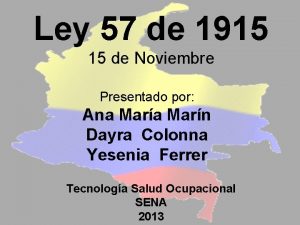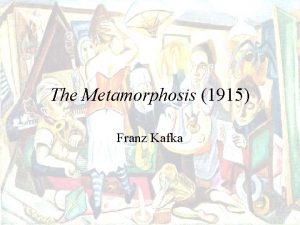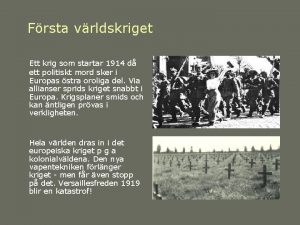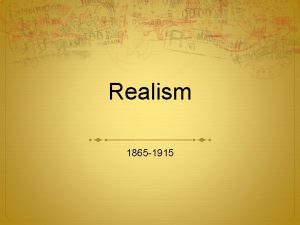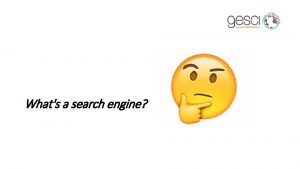Lesson 6 WW I 1915 Search for New

































































- Slides: 65

Lesson 6 WW I: 1915 - Search for New Solutions

Lesson Objectives • Understand the tactics employed in the opening months of the war and their incompatibility with the weapon technology of the period. • Understand be able to discuss the efforts to break the stalemate on the Western Front. • Be able to list and discuss the impact of the new technology employed during the war. 2

Preview Phases of World War I 1914 - Maneuver and Frustration 1915 - Search for New Solutions 1916 - Attrition 1917 - Desperation and Anticipation 1918 - Dénouement

Review of the War August 3, 1914 Germany invades Belgium; war begins Sept 5 -10, 1914 “Miracle of the Marne”; German invasion halted October 1914 Race to the Sea ends; Stalemate on Western Front 1

Western Front Stalemate! September – October 1914 BBC

Western Front They Dug In Excavating Machine … and they got good at it

Western Front Trench System, Loos, 1917

Phases of World War I 1914 - Maneuver and Frustration

Western Front What caused the stalemate? Firepower Machine gun Heavy artillery

Western Front What caused the stalemate? Firepower Machine gun Heavy artillery Outmoded Tactics

Outmoded Tactics Meanwhile … Muskets were replaced by machine guns!

Western Front What caused the stalemate? Firepower Machine gun Heavy artillery Outmoded Tactics Inability to Innovate

Phases of World War I 1914 - Maneuver and Frustration 1915 - Search for New Solutions

Breaking the Stalemate What attempts were made to break the impasse? Technology • Poison gas • Tank • Light Machine Gun

Poison Gas First used by the Germans (Ypres, April 1915) • Initially chlorine gas • Later mustard, phosgene • Violated Geneva Conventions of 1899 and 1907 Total War: A war that is unrestricted in terms of the weapons used, the territory or combatants involved, or the objectives pursued, especially one in which the laws of war are disregarded. US Military Dictionary

Poison Gas First used by the Germans (Ypres, April 1915) • Initially chlorine gas • Later mustard, phosgene • Violated Geneva Conventions of 1899 and 1907 Total War: A war that is unrestricted in terms of the weapons used, the territory or combatants involved, or the objectives pursued, especially one in which the laws of war are disregarded. US Military Dictionary

Poison Gas

Poison Gas Dispensed directly from cylinders

Poison Gas Loading Livens projectors (chlorine gas canisters) British Livens bomb projectors (mortars) (12 gal. oil cans buried in the ground)

Poison Gas

Poison Gas

Poison Gas First use by Germans had a devastating effect • Significant gap in British line Germans not prepared to exploit breakthrough

Poison Gas Early French gas mask

Poison Gas mask drill

Poison Gas mask for horses

Poison Gas Soldiers in full chemical gear

Poison Gas Casualties In perspective: Total Casualties (both sides): 30, 900, 000 Wounded: 21, 200, 000 Dead: 9, 700, 000 4. 2% due to poison gas

Tanks Attempt to create a mobile “pill box” • Initially carried machine guns • Later small cannon British Mk IV “Male” tank

Tanks First significant use at Cambrai (November 1917) 400+ tanks Breakthrough achieved but … No exploitation !

Tanks Imperial War Museum, Art 3539 Learning Curve http: //www. learningcurve. gov. uk/greatwar/g 3/cs 1/g 3 cs 1 s 6 b. htm

British Tanks Female (machine guns) Mk V Tank Male (6 -pdr cannon) Battlefield 1918 http: //ww. battlefield 1918. de/history/sct/hisdbfahr/

British Tanks Mk I Tank Male (6 -pdr cannon) BBC

British Tanks Whippet Medium Tank

French Tank Schneider CA 1 Tank

French Tank Renault FT-17 First tank with a traversing turret (AEF markings)

German Tanks German A 7 V Tank

Anti-Tank Weapons 3. 7 cm TAK Rheinmetall AT gun 1918

Anti-Tank Weapons 8 mm vs. 13 mm (top) vs. . 50 cal Mauser Tankgewehr 1918 13 mm AT Rifle

Light Machine Guns First light machine gun? Danish Madsen LMG First produced in 1897 Probert Encyclopedia http: //www. probertencyclopaedia. com/FMJ. HTM

Light Machine Gun French Chaucet British Lewis Gun

Light Machine Guns U. S. Browning Automatic Rifle – BAR – M 1918

Breaking the Stalemate What attempts were made to break the impasse? Technology Tactics • Strumtruppen (Stormtroopers) (late in war)

Strumtruppen Stormtroopers Lightly equipped, specially trained shock troops • Special weapons & tactics Used small units, bursts of movement to overwhelm objectives Bypassed strong points to attack from rear

Strumtruppen Stormtroopers Bypassed strong points to attack from rear Blitzkrieg http: //www. bellum. nu/basics/concepts/blitzkrieg. htm Strumtruppen http: //www. worldwar 1. com/arm 011. htm

Strumtruppen Stormtroopers Special weapons & equipment Machinegewehr 18 MG 18 Schmeiser Body Armor

Strumtruppen Stormtroopers Major impact during Offensive of 1918 but … Too little, too late! A

Breaking the Stalemate What attempts were made to break the impasse? Technology Tactics Strategy • Dardanelles Campaign ( Gallipoli )

Breaking the Stalemate 48 A Strategic Flanking (attempt) 48

Dardanelles Campaign Gallipoli

Dardanelles Campaign Gallipoli

Dardanelles Campaign Gallipoli

Dardanelles Campaign Gallipoli

Dardanelles Campaign Gallipoli 1915 -1916 British Commonwealth Operation Amphibious landings Attempted to force the Dardanelles, open passage to reinforce Russia

Dardanelles Campaign Gallipoli Landing operations, Sulva Bay

Dardanelles Campaign Gallipoli British force • Predominantly Australian & New Zealand (ANZAC) Achieved tactical surprise (April 1915) • Allowed Turks to reinforce Stalemate developed on the beaches British withdrew (Dec 1915 - Jan 1916) Heavy casualties • Allies: 180, 000 • Turks: 220, 000

Dardanelles Campaign 1915 -16 Living & Dying in WW I -You. Tube: 0 -2: 48 "The Circle of Modern War" and logo © Thomas D. Pilsch 2007 -2013

Breaking the Stalemate What attempts were made to break the impasse? Technology Tactics Strategy • Dardanelles Campaign ( Gallipoli ) • Maritime Blockade • Strategic Distraction ( both sides ) * ( Germany ) * * Future Lessons

Breaking the Stalemate What attempts were made to break the impasse? Technology Tactics Strategy

Review of the War August 3, 1914 Germany invades Belgium; war begins Sept 5 -10, 1914 “Miracle of the Marne”; German invasion halted October 1914 Race to the Sea ends; Stalemate on Western Front 1915 Sea blockades established around UK and Germany Feb 1915 -Jan 1916 Dardanelles Campaign (Gallipoli) Beginning of 1916 Germans accept futility of breakthrough on Western Front, adopt attrition strategy against French at Verdun 1

Lesson 7 WW I: 1916 – Attrition Warfare

Lesson Objectives • Understand the issues involved with the shift in prospects from a short war to a long war. • Understand the rationale for each side to move to attrition warfare on the Western Front. • Describe the outlooks for each of the Allied and Central powers as a consequences of the 1916 Western Front battles of attrition. 61

End

Video Title "The Circle of Modern War" and logo © Thomas D. Pilsch 2007 -2013

Artillery in WW I (6: 50) "The Circle of Modern War" and logo © Thomas D. Pilsch 2007 -2013

Tanks British Mark V tank Video Clip
 Tom thomson moonlight
Tom thomson moonlight The metamorphosis 1915
The metamorphosis 1915 La ley 57 de 1915
La ley 57 de 1915 Franz kafka, “the metamorphosis” (1915)
Franz kafka, “the metamorphosis” (1915) Frederick taylor (1856-1915)
Frederick taylor (1856-1915) Kommunista címer
Kommunista címer Acchiapparella
Acchiapparella Metamorphosis 1915
Metamorphosis 1915 1915 folkmord
1915 folkmord Fspos vägledning för kontinuitetshantering
Fspos vägledning för kontinuitetshantering Novell typiska drag
Novell typiska drag Nationell inriktning för artificiell intelligens
Nationell inriktning för artificiell intelligens Returpilarna
Returpilarna Varför kallas perioden 1918-1939 för mellankrigstiden?
Varför kallas perioden 1918-1939 för mellankrigstiden? En lathund för arbete med kontinuitetshantering
En lathund för arbete med kontinuitetshantering Adressändring ideell förening
Adressändring ideell förening Tidbok
Tidbok A gastrica
A gastrica Vad är densitet
Vad är densitet Datorkunskap för nybörjare
Datorkunskap för nybörjare Boverket ka
Boverket ka Mall för debattartikel
Mall för debattartikel Autokratiskt ledarskap
Autokratiskt ledarskap Nyckelkompetenser för livslångt lärande
Nyckelkompetenser för livslångt lärande Påbyggnader för flakfordon
Påbyggnader för flakfordon Lufttryck formel
Lufttryck formel Publik sektor
Publik sektor I gullregnens månad
I gullregnens månad Presentera för publik crossboss
Presentera för publik crossboss Jiddisch
Jiddisch Plats för toran ark
Plats för toran ark Klassificeringsstruktur för kommunala verksamheter
Klassificeringsstruktur för kommunala verksamheter Fimbrietratt
Fimbrietratt Bästa kameran för astrofoto
Bästa kameran för astrofoto Cks
Cks Verifikationsplan
Verifikationsplan Bra mat för unga idrottare
Bra mat för unga idrottare Verktyg för automatisering av utbetalningar
Verktyg för automatisering av utbetalningar Rutin för avvikelsehantering
Rutin för avvikelsehantering Smärtskolan kunskap för livet
Smärtskolan kunskap för livet Ministerstyre för och nackdelar
Ministerstyre för och nackdelar Tack för att ni har lyssnat
Tack för att ni har lyssnat Hur ser ett referat ut
Hur ser ett referat ut Redogör för vad psykologi är
Redogör för vad psykologi är Stål för stötfångarsystem
Stål för stötfångarsystem Atmosfr
Atmosfr Borra hål för knoppar
Borra hål för knoppar Vilken grundregel finns det för tronföljden i sverige?
Vilken grundregel finns det för tronföljden i sverige? Formel standardavvikelse
Formel standardavvikelse Tack för att ni har lyssnat
Tack för att ni har lyssnat Rita perspektiv
Rita perspektiv Informationskartläggning
Informationskartläggning Tobinskatten för och nackdelar
Tobinskatten för och nackdelar Toppslätskivling dos
Toppslätskivling dos Handledning reflektionsmodellen
Handledning reflektionsmodellen Egg för emanuel
Egg för emanuel Elektronik för barn
Elektronik för barn Antikt plagg i rom
Antikt plagg i rom Strategi för svensk viltförvaltning
Strategi för svensk viltförvaltning Kung som dog 1611
Kung som dog 1611 Indikation för kejsarsnitt på moderns önskan
Indikation för kejsarsnitt på moderns önskan Sju för caesar
Sju för caesar Tack för att ni lyssnade
Tack för att ni lyssnade Vilket tal pekar pilen på
Vilket tal pekar pilen på Klassens mamma rim
Klassens mamma rim Inköpsprocessen steg för steg
Inköpsprocessen steg för steg


